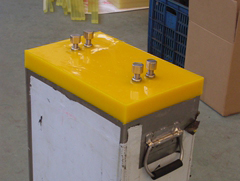Knowledge about dielectric properties of polyurethane
 Polymers have good dielectric properties
and are widely used as insulating materials. The physical quantities
representing dielectric properties include dielectric constant, dielectric loss
(tan_ delta), volume resistivity (p_ v), surface resistivity (p_ s) and
breakdown strength (or breakdown voltage). Polyurethane is a kind of strong
polar macromolecule material. Its dielectric property is not as good as that of
non-polar macromolecule, which is roughly equal to that of phenolic resin. Its
volume resistivity is 1010~1012Ω•cm, surface
resistivity is 1011~1013Ω, dielectric constant is 3-6, and dielectric loss (tan_ delta) is
about 10-2, which is not suitable for high frequency electrical
appliances. But the breakdown voltage is high, which is often used in cable
sheath, electrical appliances filling and so on.
Polymers have good dielectric properties
and are widely used as insulating materials. The physical quantities
representing dielectric properties include dielectric constant, dielectric loss
(tan_ delta), volume resistivity (p_ v), surface resistivity (p_ s) and
breakdown strength (or breakdown voltage). Polyurethane is a kind of strong
polar macromolecule material. Its dielectric property is not as good as that of
non-polar macromolecule, which is roughly equal to that of phenolic resin. Its
volume resistivity is 1010~1012Ω•cm, surface
resistivity is 1011~1013Ω, dielectric constant is 3-6, and dielectric loss (tan_ delta) is
about 10-2, which is not suitable for high frequency electrical
appliances. But the breakdown voltage is high, which is often used in cable
sheath, electrical appliances filling and so on.
The dielectric properties of polymers depend mainly on the polarity of polymers. The larger the polarity, the higher the dielectric constant, the smaller the resistance, the larger the dielectric loss and the lower the breakdown voltage. Different positions of polar groups in macromolecules have different effects on dielectric properties. The polar groups are directly connected to the main chain. Because of the influence of the configuration of the main chain, it is difficult to move, and it is not easy to rotate and orient, so the influence on dielectric properties is small. If the polar group is connected to the side base, it has a high activity. Under the action of electric field, it can rotate and orient independently, so it has a great influence on dielectric properties. There are branched chains in the main chain, which make the polymer loose. The polar groups are easy to orient along the direction of electric field. However, due to the increase of molecular spacing and the decrease of polar groups in unit volume, the influence of branched chains on dielectric properties depends on the specific situation. Macromolecules are cross-linked to form a network structure, which binds polar groups and hinders their rotational orientation, thus improving the insulation performance. In addition, the influence of external conditions on the dielectric properties of polymers cannot be ignored.
Microamounts of impurities and water in polymers, ambient temperature and humidity often lead to a significant reduction in dielectric properties of polymers. Polyurethane is a kind of strong polar material, which has a high affinity for water. Even in a relatively dry environment (50% relative humidity), polyurethane elastomer still has about 0.6% water absorption. So the effect of moisture is very difficult to avoid.










